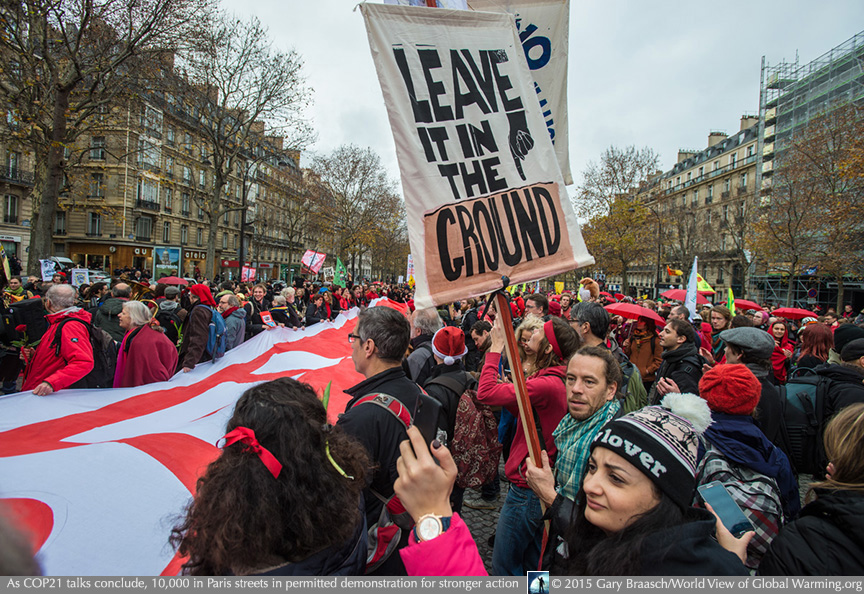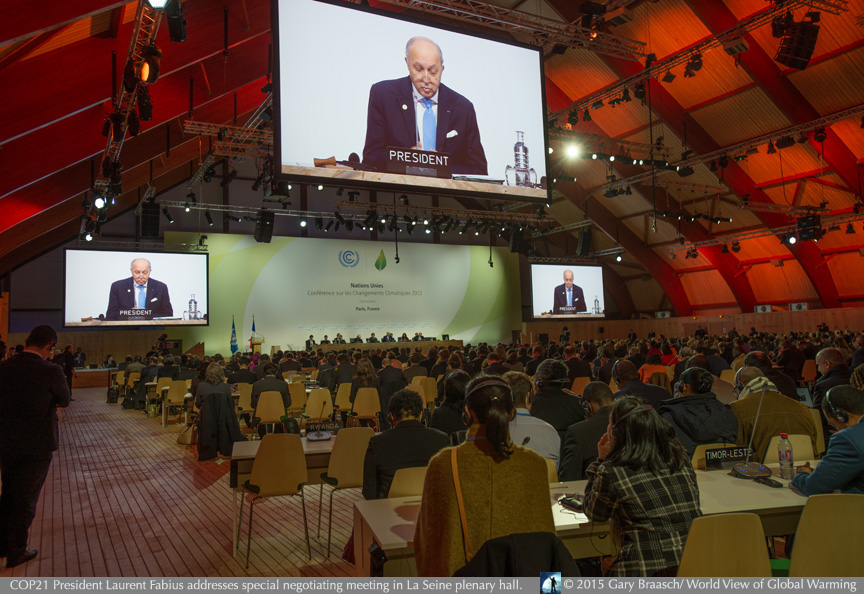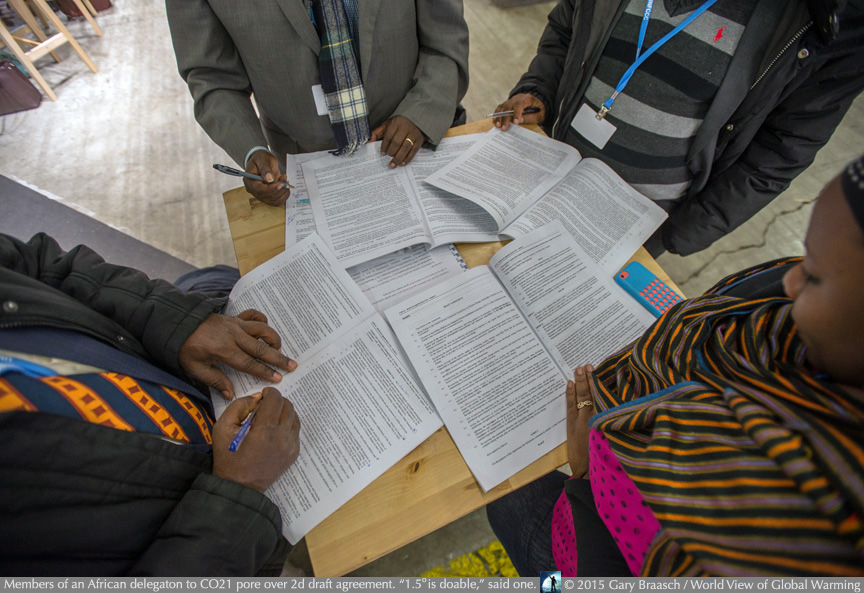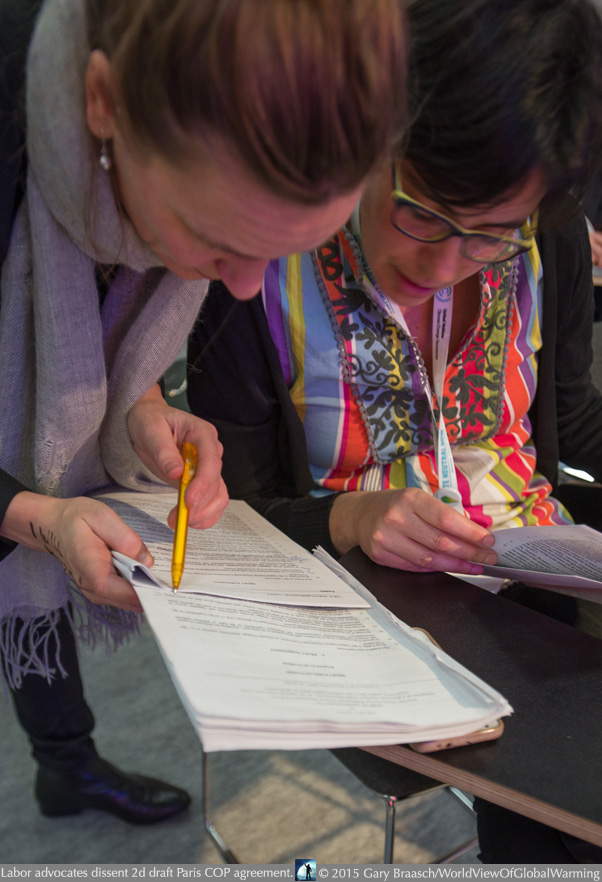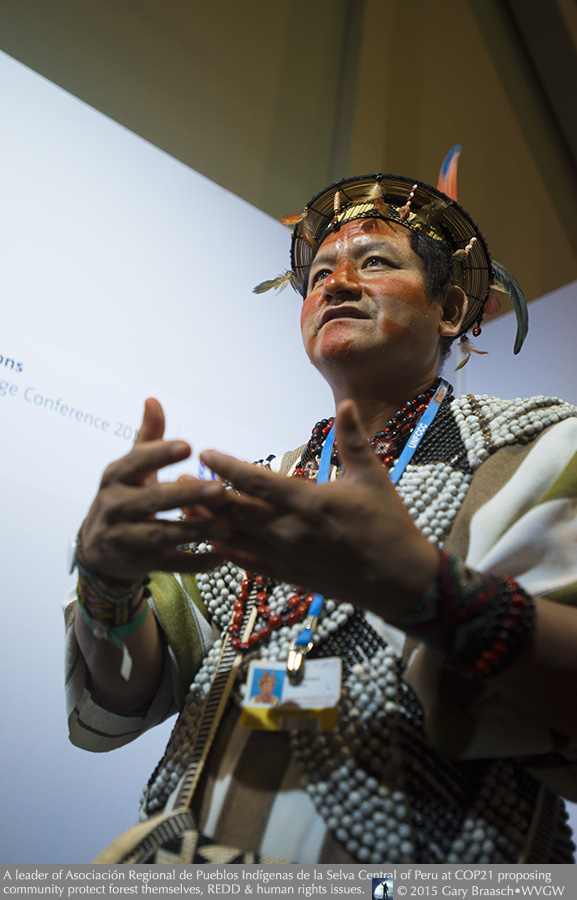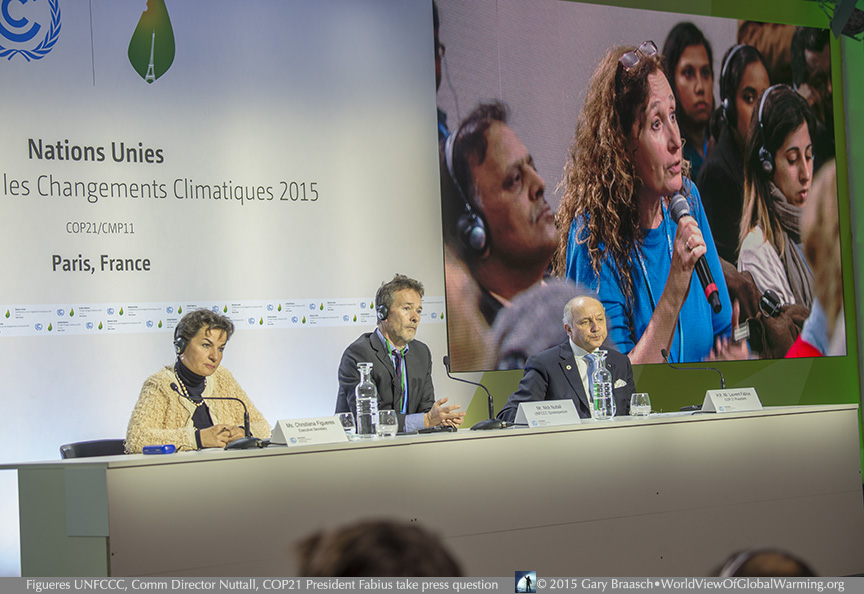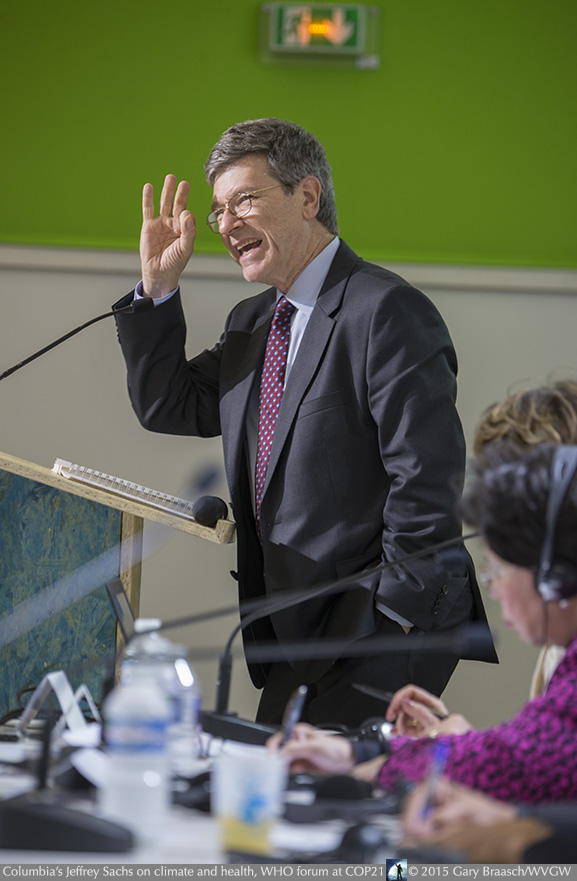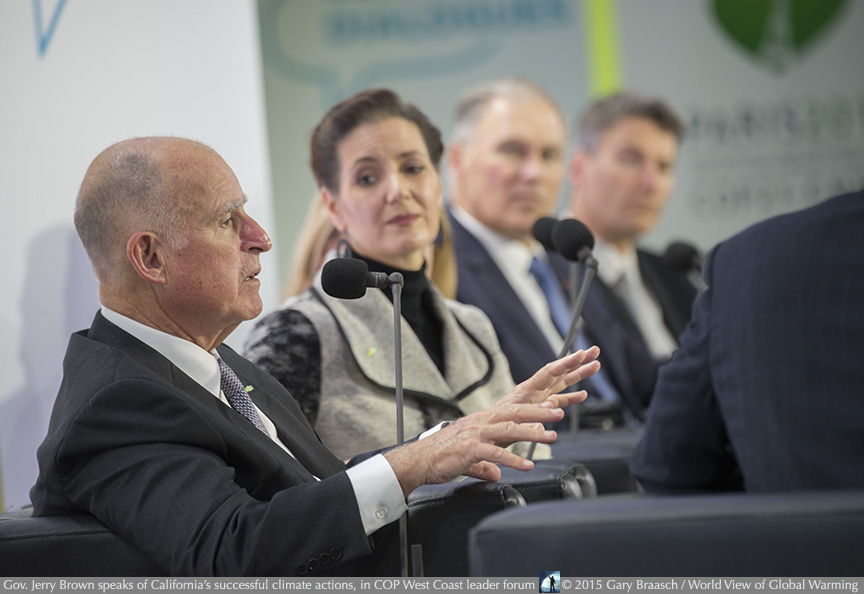World View of Global Warming is at the UN climate negotiations, the COP21, which began November 30 in Paris. I wrote in my book in 2007, “Creating a safer, cleaner—and cooler—world. This is the direction for change. The world’s nations will recognize in global warming a common danger to their people, their cultures, and the Earth that supports them all.” We will see if we have finally reached that day.
Climate Photo of the Week
Paris climate talks produce an historic agreement that finally directs all nations to sharply limit global warming. As final negotiations were proceeding, thousands of citizens in Paris marched near Arc de Triomphe to urge an even stronger agreement.
For more photos from COP21 and associated events in Paris, please see
COP21 Photos 8 | 7 | 6 | 5 | 4 | 3 | 2 | 1
The UN Climate Convention voted December 12 to set an international goal to “hold the increase in the global average temperature to well below 2°C above pre-industrial levels and to pursue efforts to limit the temperature increase to 1.5 °C” This will finally set all nations on a path set in international law to sharply limit global warming pollution and its effects.
Ministers and staff members of the 192 signatories to the UN Convention on Climate Change were working into early Friday morning at Le Bourget near Paris to resolve still-serious differences in the draft over financing the transition, increasing and verifying the specific actions of all nations to limit carbon emissions, and recognizing and paying for irreversible losses and damage from climate change effects. The leadership of this conference of the parties (COP) has pushed hard to get a strong agreement by Friday December 11. The new draft contains 16 pages of decisions, which usually lead to action by the convention but do not become part of international law, and 11pages of the actual agreement, which does carry legal weight.
The new draft was released about 9:30 pm just as the main negotiating body of COP21 was beginning a meeting. Hundreds of national delegation staff members, observers and media crowded a documents window or hunched over laptops to get the document.
Initial reaction was generally favorable about the temperature goal but concerned over how the pact would actually move toward reducing global warming. The current pledges by more than 180 nations — which are in themselves a significant advance in reducing global warming from an unrestrained 6 to 9 degrees increase to 3 to 4 degrees above preindustrial — will not fulfill the draft agreement of 1.5 to 2 degrees. Delegates from an African nation said that at first look the goal was good, and they thought holding temperatures to the 1.5 level was “doable.” Long time climate negotiation watcher Alden Meyer of the Union of Concerned Scientists said "this is good progress… I’m hopeful we’ll get where we need to be.” He warned that much depends on the final day of negotiation and that “no one is going to get everything they want,” including the nations who are most affected now by climate disruption.
Although recognition of gender issues in climate, the special plight of small and island nations and the special knowledge of indigenous communities remained in the text, advocates were dismayed by the removal of mention of human rights in the core final agreement. Ben Schachter, a human rights officer with the UN High Commision on Human Rights, said they were concerned because it is important "that states are honoring their commitment to respect human rights for all people.” Other human rights and environmental advocates denounced the new draft for making the goal of 1.5 degrees only as something to “pursue,” not the actual target, for lack of specifics about immediate reduction in climate emissions rather than waiting for 2020, and for the conflicted wordings about finance and loss and damage — which remain to be negotiated into Friday morning.
Previously we reported:
Many indigenous communities sent representatives to Paris to be part of their national delegations and to lobby strongly for local control, a free flow of funds and technology to help them, and an stop to industrialized logging, mining and oil extraction which have destroyed native lands and added much to the global load of carbon the atmosphere. An important issue for these groups and many women’s spokespeople at the COP was payment for loss and damage from rapid climate changes. This is a subject that has been discussed in previous meetings for decades, but never resolved. Compensation to people and nations harmed by irreversible and permanent harm can be simple insurance, but inevitably brings up legal liability and reparations — which major climate negotiations nations steadfastly reject. It appears this COP21 agreement will keep to the work plan from the Warsaw COP two years ago not to address this issue until COP 22.
The French leadership of the COP — Conference of the 192 Parties, the signatory nations of the UN Climate Convention -- divided the talks into eight topics in order to keep them going and meet the Friday deadline. The most divisive issues are not surprisingly who should pay whom and how much for the costs of energy switching and adapting to effects and damages caused by global warming, what each nation should actually do to reduce emissions and if actions will be mandatory, and how soon the agreement would take effect and how often actions would be measured and adjusted. The paragraphs in the new draft are continuous strings of bracketed options which must be worked out among nations with often conflicting needs, especially those countries dependent on or major suppliers of, fossil fuels versus small island states.
Myriad citizen and lobby groups in hundreds of press conferences, forums, demonstrations and exhibits around the official meeting place and throughout Paris warned that without an ambitious, compreshensive, fair and binding international agreement, dire effects on health, women and children, low-lying nations, the disadvantaged, native communities and biodiversity will increase to a deadly pace. Strong effects on all of these and more from the current one degree of human-caused warming and carbon dioxide emissions are already scientifically documented. In a meeting sponsored by the World Health Organization, Columbia University’s Dr. Jeffrey Sachs referred to a the record air pollution in Beijing: “The timing of the red alert in China this week is a red alert for the whole planet … we’ve gone too far.”
And in remarks at the COP Wednesday afternoon, Secretary of State John Kerry said, "So we gather this week in Paris, knowing that the Conference of the Parties, this Conference of the Parties, may be the best chance we have to correct the course of our planet. And we gather to chart a new path – a sustainable path – to prevent the worst, most devastating consequences of climate change from ever happening.” "It’s that simple,” Kerry said. "That is the choice. My friends here in Paris now, we have the rarest of opportunities to actually change the world, to improve the lives of millions of people. And in the next few hours, we need to work as never before not to let this opportunity slip by. We need to do whatever it takes to have the tough conversations that we need to have, to make the compromises that we need to make, and to give the world the agreement that it deserves and demands."
The concept of climate justice is mentioned only once in the active part of the draft Paris agreement, in the section about how carbon emission cuts would be done. Human rights, the right to health, land rights of indigenous cultures, and food security, are mentioned mostly in the preamble to the draft agreement, which recognizes issues but is not binding. Gender and indigenous cultures get some mention in the active text. Climate justice is being urged by a wide span of interests from business groups to native culture individuals. Many people from forested regions were advocating various forms of forest protection to cut pollution, sequester carbon and harbor biodiversity (called REDD in convention language), and some opposed any continuation of forest “management” by corporations and industrialized nations.
Central to all of this and more was whether the consensus process within the UN convention could deliver a strong, binding, transparent and equitable agreement now. Under United Nations procedure requiring consensus, a single nation can refuse to agree, sending the whole process back toward a weaker position.
Many other side meetings at the COP celebrated the solutions to rapid climate change already being undertaken around the world. A major outcome of the Lima COP one year ago was an initiative to highlight and encourage advances in new and clean energy, carbon pricing, actions by cities, states and companies — who are not waiting for an international agreement. The first day of the COP, with Obama and President Hallande of France, Bill Gates announced a multi-billion dollar fund for accelerated clean energy development and deployment. Renewable and clean energy to carry out the needs of the world for health, climate and fairness was being put forward in many studies and reports, in advance of the climate meeting.
Much more to come as this crucial agreement reaches its final draft and the nations move forward. World View of Global Warming will be photographing and reporting daily from the COP.
COP21 Photos 8 | 7 | 6 | 5 | 4 | 3 | 2 | 1
COP21, UN climate negotiations, Paris, Nov-Dec 2015
COP21, the Paris Climate Talks, December 4, 2015
COP21, the Paris Climate Talks, December 8, 2015
COP21, the Paris Climate Talks, December 9, 2015
COP21, the Paris Climate Talks, December 12, 2015
COP21, the Paris Climate Talks, December 13, 2015
15 years of World View of Global Warming, documenting climate change 1999-2015
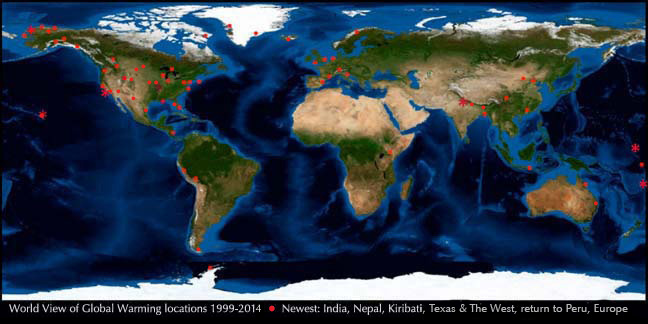
This project would be impossible without scientists and observers around the world who have provided hundreds of scientific contacts and papers. See Background, Advisors, and Reference for documentation, funders and major advisors, without whom I could not complete the work.
World View of Global Warming is a project of the Blue Earth Alliance, Seattle Washington, a 501(c)3 tax-exempt organization. The project is supported entirely by donations, grants, and license fees for the photographs. Please see information about how to contribute.
For other information about Gary Braasch's climate change projects and books, please see the books Earth Under Fire and How We Know What We Know About Our Changing Climate, and the exhibit "Climate Change in Our World" at the Books and Exhibits link on the top menu of this page.
COPYRIGHT NOTICE:
Photography and text Copyright © 2005 - 2017 (and before) Gary Braasch All rights reserved. Use of photographs in any manner without permission is prohibited by US copyright law. Photography is available for license to publications and other uses. Please contact requestinformation@worldviewofglobalwarming.org. View more of Gary Braasch's photography here.



